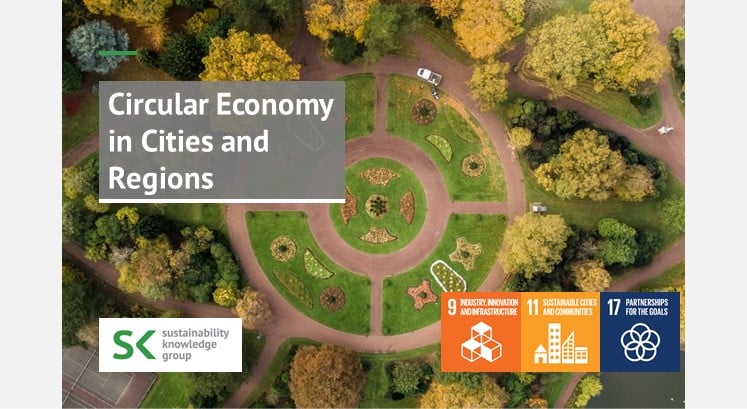The concept of circularity is not new and the need to adopt circular practices in business and beyond is becoming even more pressing. COVID-19 has highlighted unsustainable environmental and social trends, contributing to a re-examination of production and consumption patterns. The traditional understanding of economic activity is based on a linear model, where natural resources are extracted and transformed into products, which then consumers use and then dispose based on a “take-make-dispose” process. Linear economy ignores high economic, environmental, and social costs, and thus is unsustainable in the long run. Circular economy, is considered an example of resilience in the face of crises, as it preserves the value of products, materials, and resources for as long as possible, with the purpose of eliminating waste. Cities and regions play an essential role in the global economy, and play an important role in the move from a linear to a circular model.
A circular economy as a transformative opportunity
Cities are home to more than half of the world’s population and responsible for major policies in local public services such as transportation, solid waste, water, and energy management that affect economic growth and environmental health. Applying the principles of circular economy in cities and regions yields economic, social, and environmental benefits in line with the Sustainable Development Goals (SDGs).
- Economic benefits: Contributes to the creation of cities that can prosper economically in the long term. It increases production rates and achieves savings related to improving resource efficiency. It also supports opportunities for growth, innovation and new business development.
- Social benefits: It achieves prosperity and well-being for citizens, as it improves air quality and reduces pollution, thus creating livable cities. It also creates job opportunities and enhances community participation.
- Environmental benefits: Preserves the planet and reduces its environmental impact by reducing congestion and eliminating waste. It improves resource security, as it reduces dependency on raw materials, in addition to achieving a balance between local production and global supply chains.
Cities and Circular Areas Initiative (CCRI)
The Cities and Circulars Initiative (CCRI) is part of the Circular Economy Action Plans (CEAPs) and focuses on implementing circular solutions at local and regional level.
An increasing number of cities and regions are participating in the formulation of various CEAPs. For example, Amsterdam has adopted the “Doughnut Economic” model, a sustainable framework developed by economist Kate Raworth.
The Doughnut model is a holistic approach that balances social needs without harming the environment. The inner ring defines the minimum individuals need to lead a good life. The outer ring represents the environmental ceiling as defined by scientists, which highlights the limits that humans must not cross. Between the two rings are the matters that represent the absolute needs of everyone and the needs of the planet.
The 3Ps framework: People, policies, and places
The circular economy in sustainable cities, regions, and countries still needs to be activated, and can be achieved based on the Three Dimensions of People, Policies and Places (3Ps). The 3Ps provides a conceptual framework for making a circular economy happen in cities and regions. The circular economy requires:
- People: A shift towards sustainable production and consumption pathways, as well as new business and governance models (e.g. use of secondary materials, recycling, and sharing)
- Policy: A holistic and systemic approach intersecting with sectoral policies (e.g. environmental policies, regional development, agricultural and industrial policies)
- Places: Adopting a functional approach that goes beyond the administrative boundaries of cities and regions and links them to surrounding areas and beyond.
Governance gaps
Cities and regions may face challenges when moving from a linear to a circular economy. According to the Organisation for Economic Co-operation and Development (OECD) Survey on Circular Economy in Cities and Regions, there are five main categories of gaps:
- Financial gaps: Insufficient financing, financial risks, lack of critical scale of business and investments
- Regulatory gaps: Inadequate regulatory frameworks, and incoherent regulation across levels of government
- Policy gaps: Lack of a holistic vision, poor leadership and co-ordination, lack of political will
- Awareness gaps: Cultural barriers, lack of awareness, and inadequate information
- Capacity gaps: lack of capacity, skills, and human resources
Towards circular economy for cities
Cities and regions contribute significantly to Europe’s transition towards a more circular model. Circular economy thrives on cooperation, and the best way to adopt successfully circular frameworks is to join forces with those who want to move in the same direction and make a difference.
Local and regional authorities have an important role to play in launching and accelerating the transition to the circular economy. Promoting a culture of circular economy and providing clear information and setting goals and objectives is key to success. Facilitating communication, dialogue, and cooperation, as well as enabling appropriate governance conditions and defining regulatory tools is seen as a prerequisite for this transition. Shared responsibility between governments and stakeholders will help in promoting, facilitating, and ultimately enabling this transition.
Photo by Josh Power on Unsplash

